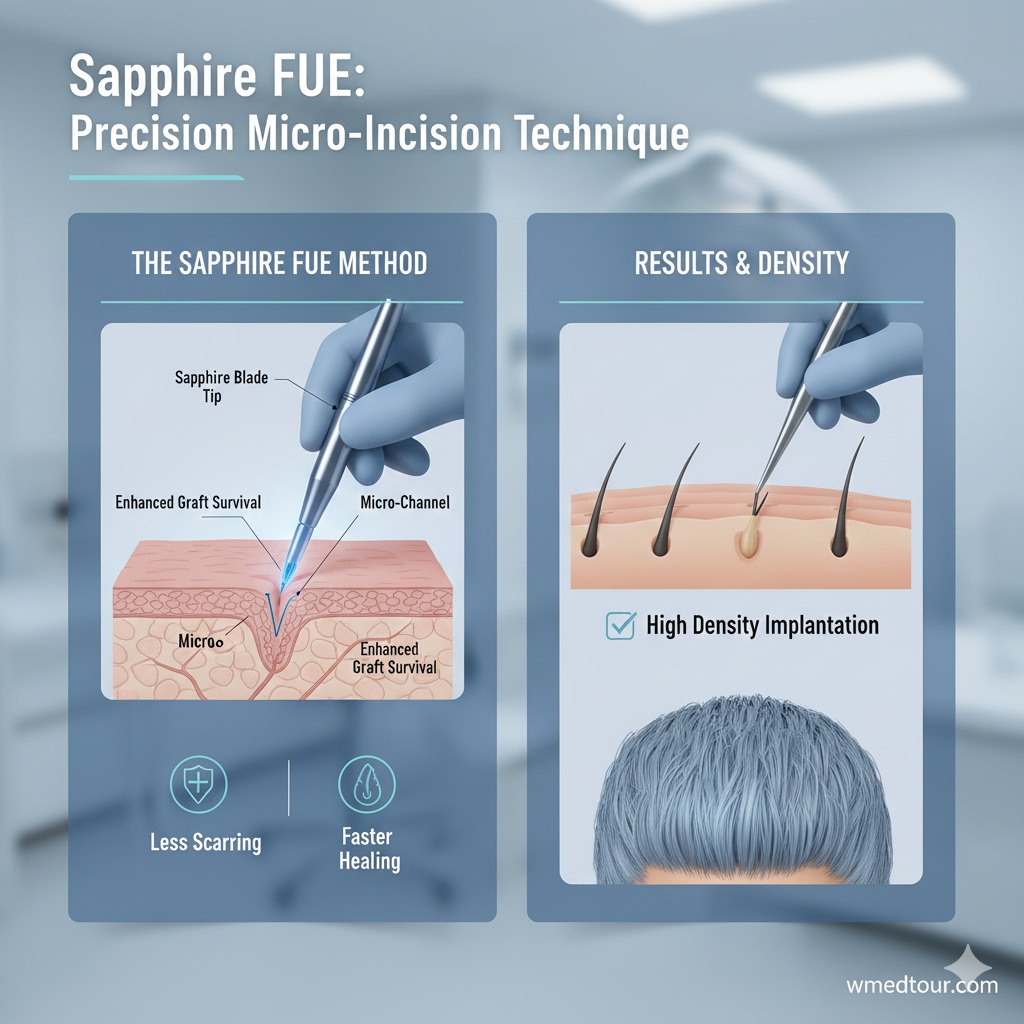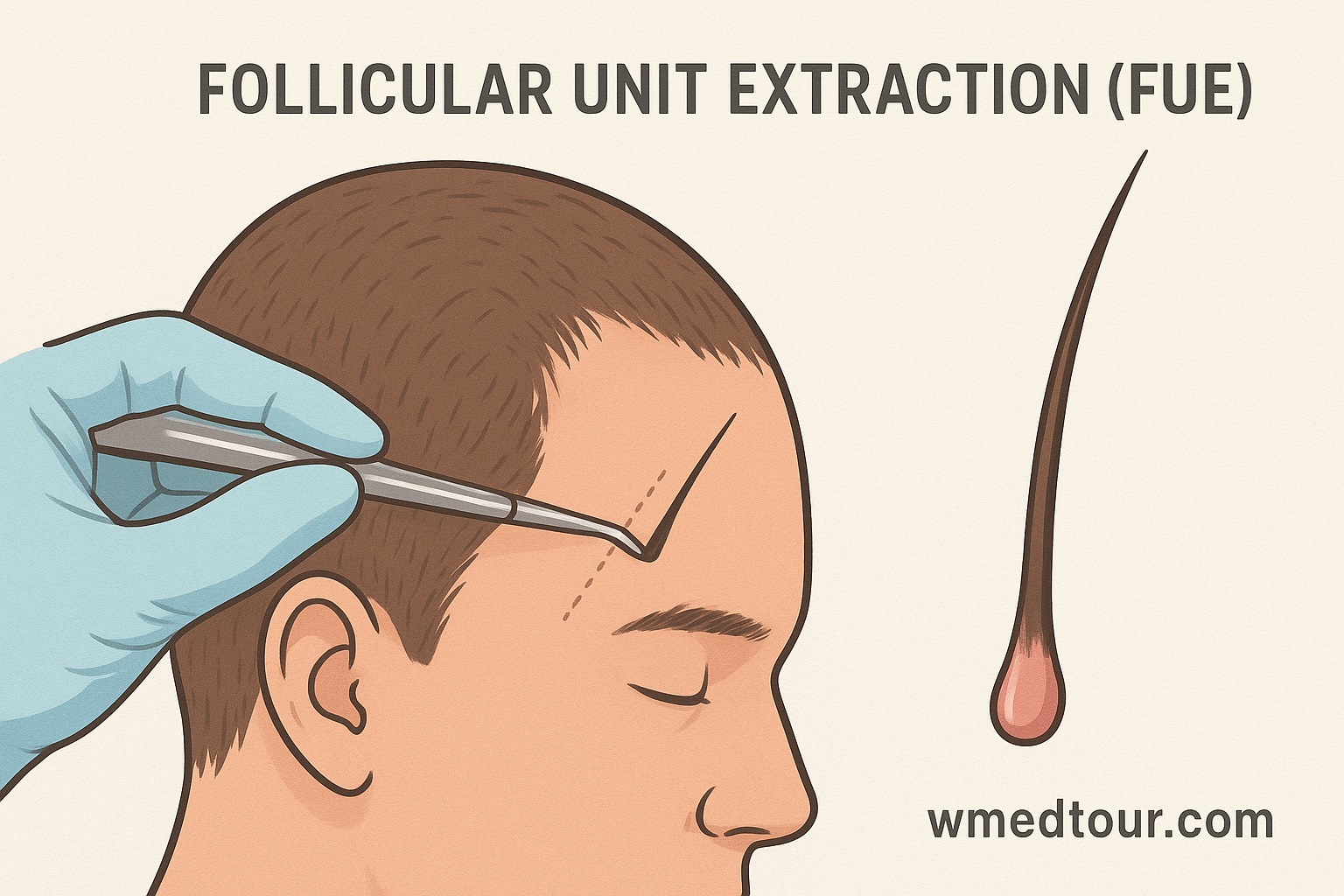🔍 What is an FUE Hair Transplant?
FUE stands for Follicular Unit Extraction. It is the modern gold standard in hair restoration. Unlike older methods, it does not involve cutting a strip of skin. Instead, the surgeon works with individual units. This approach minimizes trauma. Consequently, it reduces visible scarring.
The Biological Mechanism
Hair grows in groups of 1 to 4 hairs. These are called follicular units. During an FUE Hair Transplant, the surgeon extracts these units from a “donor area.” This area is usually the back of the head. This hair is genetically resistant to balding. Therefore, when moved to the thinning area, it continues to grow. For a deeper understanding of hair biology, you can reference this study by The National Institute of Arthritis and Musculoskeletal and Skin Diseases.
The procedure involves three main phases:
- Extraction: Using a micro-punch tool (0.6mm-1.0mm).
- Incisions: Creating tiny channels in the recipient area.
- Implantation: Placing the grafts into these channels.
You can browse our specific Hair Transplant Procedures to see variations of this technique.
👥 Who is This For?
Not everyone is a perfect candidate. Understanding your eligibility is crucial. It saves time. It manages expectations.
Ideal Candidates
- Pattern Baldness: Men with Male Pattern Baldness (Norwood Scale 3-7).
- Stable Hair Loss: Patients whose hair loss has stabilized.
- Good Donor Supply: You must have enough density at the back of the head.
- Realistic Expectations: Those who understand that density improves, but may not equal teenage thickness.
Who Should Avoid It?
- Insufficient Donor Hair: If the back of the head is thin, results will be poor.
- Unrealistic Goals: Perfection is impossible. Improvement is the goal.
- Certain Medical Conditions: Uncontrolled diabetes or blood-borne illnesses may be contraindications.
- Very Young Patients: If you are under 25, hair loss patterns are not yet established.
If you are unsure, visit our Checkup Department page to understand pre-surgical health requirements.
⚖️ Pros and Cons Breakdown
Every medical procedure has advantages and disadvantages. We believe in total transparency. Here is a detailed breakdown of the FUE Hair Transplant.
👍 The Pros
- No Linear Scar: You can wear short hairstyles without a visible scar line.
- Fast Recovery: The micro-wounds heal within days. Discomfort is minimal.
- Natural Look: Skilled surgeons mimic natural growth angles.
- Versatility: It can be used for beards, eyebrows, and scar camouflage.
- High Graft Survival: Modern storage solutions keep follicles healthy out of the body.
👎 The Cons
- Time-Consuming: The surgery can take 6 to 10 hours depending on graft count.
- Donor Depletion: Over-harvesting can leave the back of the head looking thin.
- Cost: It is generally more expensive than older strip methods.
- Shaving Required: Usually, the donor area must be shaved fully.
- Fragile Grafts: Extracted follicles are delicate and require expert handling.
📊 Comparison Table: FUE vs. FUT vs. DHI
Confusion often exists between different methods. The table below clarifies the differences. This helps you make an informed decision.
| Feature | FUE (Standard) | FUT (Strip) | DHI (Direct Hair Implantation) |
|---|---|---|---|
| Extraction Method | Individual punches | Strip of skin | Individual punches |
| Scarring | Tiny white dots (hidden) | Linear scar | Tiny white dots (hidden) |
| Recovery Time | Fast (5-7 days) | Slow (10-14 days) | Fast (5-7 days) |
| Cost | Moderate | Lower | Higher |
| Suitability | Most patients | High graft needs | High density/Unshaven |
Research suggests that patient satisfaction is higher with FUE due to the lack of scarring. You can read more about satisfaction rates at PubMed Central.
🛣️ The Patient Roadmap
Navigating the medical process can be daunting. We simplify it here. This roadmap outlines the typical steps for a patient at WMEDTOUR.
Phase 1: Research and Consultation
This is where you start. You browse our Doctors Directory. You look for specialists. Then, you submit photos for an assessment. The doctor estimates the graft count.
Phase 2: Preparation
Two weeks before surgery, you must stop blood thinners. Smoking should cease. Alcohol is restricted. You might need a pre-operative anesthesia consultation if you have health risks.
Phase 3: The Surgery Day
You arrive early. Hairlines are drawn. Local anesthesia is applied. The extraction begins. A lunch break follows. Then, the implantation occurs. You leave the clinic the same day with a bandage.
Phase 4: Post-Op Care
The first wash happens after 48 hours. Scabs form and fall off by day 10. We often recommend PRP Therapy to boost healing during this phase.
📂 Case Study: Michael’s Journey
Note: This is a hypothetical case study based on typical patient data.
Patient: Michael, 34 years old.
Origin: Manchester, UK.
Problem: Receding hairline (Norwood 3) and thinning crown.
Goal: Restore the frontal hairline without looking “fake.”
The Process:
Michael contacted WMEDTOUR. He was hesitant about traveling. However, the cost in the UK was prohibitive (£10,000+). He chose a clinic in Turkey through our platform. He required 3,200 grafts.
The Result:
The surgery took 7 hours. He experienced mild swelling on day 3. By month 4, “shock loss” (temporary shedding) had ended. New growth began. By month 12, Michael had a full hairline. He saved approximately 65% on costs compared to UK prices. He also utilized our Turkey Medical Tourism packages for seamless transport.
💰 Cost Analysis 2026
Cost is a major driver for FUE Hair Transplant decisions. Prices vary wildly by location. However, quality does not always correlate with the highest price. Here is an estimated comparison for 3,000 grafts.
| Region | Estimated Cost (USD) | Notes |
|---|---|---|
| USA / Canada | $12,000 – $20,000 | High labor and facility costs. |
| UK / Europe | $8,000 – $15,000 | Strict regulations, high overheads. |
| Turkey | $2,000 – $4,500 | Government incentives, high competition. |
| India | $1,500 – $3,500 | Cost-effective, skilled surgeons. |
| Mexico | $3,000 – $6,000 | Popular for US patients. |
For specific packages, check our offers in India or other regions. Remember, the quote often includes hotels and transfers in medical tourism hubs.

✈️ Recovery & Medical Tourism
Combining surgery with travel requires planning. You cannot treat it like a standard vacation. Here are essential tips.
The Recovery Timeline
- Days 1-3: Rest is vital. Keep your head elevated. Do not touch the grafts.
- Days 4-7: Swelling subsides. You can wash your hair gently.
- Days 10-14: Scabs fall off. You look socially presentable.
- Months 1-3: The “Ugly Duckling” phase. Transplanted hair sheds.
- Months 6-12: Real growth begins. Thickness increases monthly.
Tourism Tips
If you travel, arrive a day early. This allows you to rest. After surgery, stay at least 2 days before flying. Changes in cabin pressure are generally safe, but comfort is key. Ensure you have a neck pillow. View our Global Medical Tourism Guide 2025 for detailed logistics.
Additionally, consider supportive treatments like Mesotherapy during your stay to enhance scalp health.
⚠️ Medical Disclaimer
Important: The information provided in this blog post is for educational purposes only. It does not constitute medical advice, diagnosis, or treatment. Always seek the advice of your physician or other qualified health providers with any questions you may have regarding a medical condition. Do not disregard professional medical advice or delay in seeking it because of something you have read on this website. Results vary by individual.
❓ Frequently Asked Questions (FAQ)
Here are the answers to the most common questions regarding FUE Hair Transplant.
1. Is the FUE Hair Transplant procedure painful?
Generally, no. Local anesthesia is used to numb the scalp. You may feel a slight prick during the injection. During the extraction and implantation, you feel no pain. Post-operative discomfort is mild and manageable with basic painkillers.
2. Will the transplanted hair fall out again?
No, the transplanted hair is permanent. It is taken from the donor zone, which is genetically resistant to the hormone DHT that causes hair loss. However, you may experience temporary shedding of the hair shaft in the first few weeks, but the root remains alive.
3. How long does the operation take?
The duration depends on the number of grafts needed. A standard session of 3,000 grafts typically takes between 6 to 8 hours. You will have breaks for lunch and restroom needs during the day.
4. Can I wear a hat after surgery?
You should avoid wearing tight hats for at least 10 days. The grafts are loose and need to anchor securely. A loose bucket hat may be allowed by your surgeon after 3 or 4 days to protect from the sun.
5. When can I return to work?
If your job involves desk work, you can return in 3 to 5 days. However, if your job requires heavy lifting, sweating, or wearing a helmet, you should wait at least 14 days to prevent dislodging grafts or increasing swelling.
6. What is the success rate of FUE?
In experienced hands, the graft survival rate is typically between 90% and 95%. Success depends heavily on the surgeon’s skill, the technology used, and how well you follow the aftercare instructions.
7. Does the donor area grow back?
No, the follicles removed from the donor area do not grow back. However, the extraction is spread out evenly. Therefore, with a skilled surgeon, the thinning in the back of the head is virtually unnoticeable to the naked eye.
8. Can women have FUE transplants?
Yes, many women are candidates. However, the pattern of hair loss in women is different. It is often diffuse. A consultation is necessary to determine if the donor area is stable enough for a successful transfer.
9. Are there financing options available?
Many clinics and medical tourism agencies offer payment plans. Additionally, because the cost abroad is significantly lower, many patients find they can pay out of pocket without needing long-term financing.
10. How many grafts do I need?
This varies by individual. A receding hairline might need 1,500 to 2,000 grafts. Extensive balding (front to crown) might require 3,500 to 4,500 grafts. Only a professional assessment can give an accurate number.
11. What is “Shock Loss”?
Shock loss is the temporary shedding of native hair surrounding the transplant area due to surgical trauma. It is usually temporary. The hair typically grows back within 3 to 4 months along with the transplanted hair.
12. How do I choose the right clinic?
Look for before-and-after photos that show clear lighting. Check the surgeon’s credentials. Read verified reviews. Ensure they specialize in FUE. You can start by checking our About Us page to see how we vet our partner clinics.
Ready to transform your look? Visit our Contact Us page today to begin your journey toward confidence.




